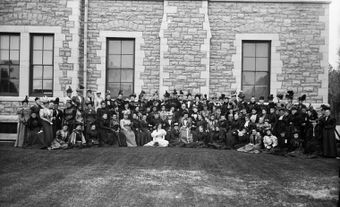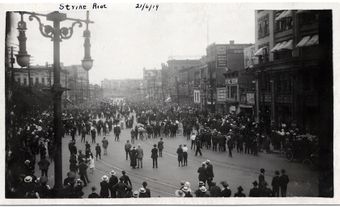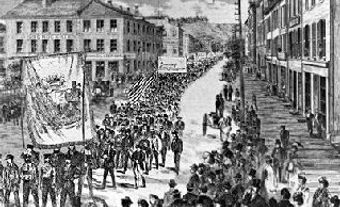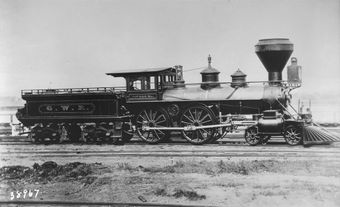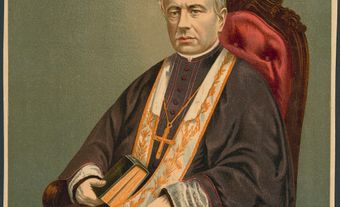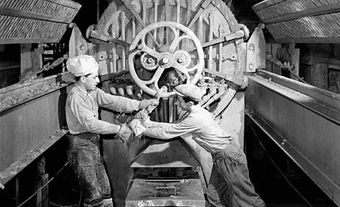The Nine Hour Movement was an international phenomenon, taking place in Canada between January and June 1872. The movement’s goal was to standardize shorter working days. Though this particular mandate was unsuccessful, the movement did have an impact, including setting the foundation for the Canadian Labor Union.

Background
The Nine Hour Movement was an international workers’ attempt to secure shorter working days. In Canada, the movement took place between January and June 1872. Beginning in Hamilton, the demand for the nine-hour day (some workers were expected to labour as long as 12 hours) spread quickly to Toronto and Montreal, gathering support in Ontario towns from Sarnia to Perth. Echoes were heard as far east as Halifax. For the first time, Canadian labour organized what might be considered the beginnings of a unified protest movement.
Movement Leaders
Among the leading figures in the shorter-hours mobilization were Toronto’s J.S. Williams and John Hewitt, a printer and a cooper, respectively; Hamilton’s James Ryan, a Great Western Railway engineer; and James Black, employed at Montreal’s Grand Trunk Railway works. Railway mechanics like Ryan and Black would figure prominently in the attempt to create a broad, pan-Canadian movement of agitation around the shorter-hours question. Ryan traveled to Montreal, developing a coordinated strategy of specific actions in Hamilton and Toronto that might be supported by Montreal workers. He also encouraged the formation of Nine Hour leagues. Unlike anything that had appeared in Canada before, these leagues united union and non-union workers, breaking down barriers between them and building connections across central Canada. By March 1872, with Black as its president, Montreal’s Nine Hour League boasted 2,000 members.
Development
At the height of the agitation for shorter hours, the Ontario Workman newspaper was founded on cooperative principles in Toronto by J.S. Williams and other printers affiliated with the Toronto Typographical Union (TTU) Local 91. With Williams as its editor, this pioneer labour newspaper was a reflection of the complicated mix of forces, old and new, that the mobilization for the nine-hour day drew together.
On the one hand, Williams challenged employers with labourers’ collective strength. As a prominent figure in the shorter-hours movement and a leading member of the TTU Vigilance Committee, he helped organize an April demonstration of 10,000 and led a highly publicized strike against Toronto’s master printers. The latter job action culminated in Williams’s arrest on conspiracy charges. On the other hand, Williams and a number of other Toronto leaders retained close connections to Conservative Party leader Sir John A. Macdonald. It was Macdonald who later provided funds to keep the Ontario Workman afloat and in the hands of his Tory workingman friends.
Between March and April, the controversy around the eventually unsuccessful Toronto printers’ strike reminded workers how antagonistic employers were to labourers’ new initiatives. Trade unions were declared illegal in Canada, as they were judged to be conspiracies in restraint of trade under a particular reading of older British law (see Labour Organization; Working-Class History). Undaunted, John Hewitt championed the formation of the Canadian Labor Protective and Mutual Improvement Association in Hamilton on 3 May 1872.
Meanwhile, Hamilton leader James Ryan aimed to strategically stagger demonstrations over the course of May and June 1872, culminating in a massive show of force. However, the printers’ strike, as well as related attacks launched by the newspaper owner George Brown and other employing printers, forced Ryan to act sooner. On 15 May, Hamilton's “nine-hour pioneers” defied opposition with a procession of 1,500 workers, a virtual general strike of the city’s skilled workingmen. At this point in the movement, labour reform seemed attainable.
Impact
Despite the momentum felt in the spring of 1872, the Nine Hour Movement was largely unsuccessful. Employer hostility and waning post-Confederation prosperity spelled its defeat. Also significant were divisions within the working class. Women and unskilled workers figured peripherally at best, ensuring that the struggle touched certain sectors more fully than others. (See also Women in the Labour Force.)
However, the Nine Hour Movement was not an utter failure. Workers declared that their interests, institutions and political stance were reflective of their distinct economic needs. The Canadian Labor Protective and Mutual Improvement Association gave way to the Canadian Labor Union, formed in April 1873.
The Canadian Labor Union was possible, it could be argued, because working-class activists won major concessions immediately after the demise of the Nine Hour Movement of 1872, including the limited right to associate in trade unions, the repeal of repressive legislation, the passage of laws strengthening workers’ opportunities for action against employers, and franchise extension.
Sir John A. Macdonald, Canada’s prime minister at the time, had seen the possibility of class struggle rear its worrisome head in the newly formed country’s Nine Hour leagues. He feared what he called “the Chartist proclivities” of Canadian workingmen, a reference to the British Chartist movement of the 19th century, which produced demands for universal suffrage and untold battles between employers and labourers. Macdonald thought that in granting the emerging workers’ movement concrete, if curtailed, concessions, he would consolidate a relationship with labouring people that would last into the next decades. During the 1880s, however, Canadian workers organized more trade unions, fought more strikes and developed a more wide-reaching movement, centered in the Knights of Labor, than had ever been imaginable in the early 1870s.
The Nine Hour Movement was a forerunner of these 1880s developments, a transition in the struggle to create institutions and mobilizations of Canadian workers.

 Share on Facebook
Share on Facebook Share on X
Share on X Share by Email
Share by Email Share on Google Classroom
Share on Google Classroom


